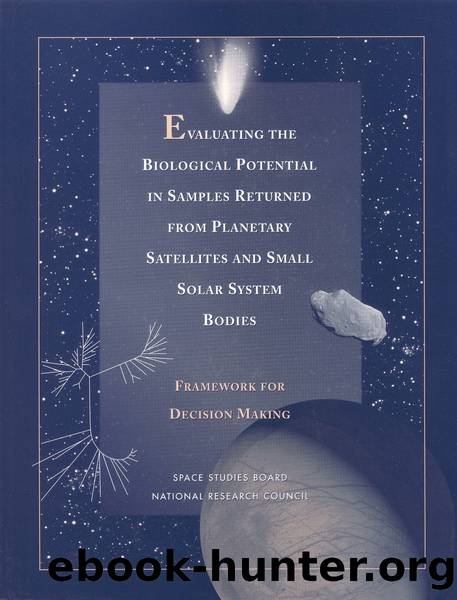Evaluating the Biological Potential in Samples Returned from Planetary Satellites and Small Solar System Bodies: Framework for Decision Making by Task Group on Sample Return from Small Solar System Bodies

Author:Task Group on Sample Return from Small Solar System Bodies
Language: eng
Format: epub
Tags: Space and Aeronautics : Space Exploration and Development
Publisher: NATIONAL ACADEMY PRESS
Published: 1998-09-15T00:00:00+00:00
UNDIFFERENTIATED, PRIMITIVE (C-TYPE) ASTEROIDS
C-type asteroids are very black objects, typically reflecting only 3 to 5 percent of incident sunlight. They have reflectance spectra that are relatively neutral in color throughout the visible and near-infrared, except for a prominent absorption feature (present in only some of them) near 3 µm, owing primarily to water of hydration (Jones et al., 1990). These features are roughly typical of laboratory spectra of carbonaceous chondritic meteorites (Feierberg et al., 1981). There are minor discrepancies in matching meteorite and asteroid spectra, and also minor variations among asteroid spectra that have resulted in additional classes of asteroids (G- and B-types are lumped in with the C-type asteroids).
Although it is not rigorously proved, it is likely that the C-type asteroids (which are overwhelmingly the most abundant type in the main belt, especially the middle and outer parts) are represented in various meteorite collections1 by carbonaceous chondrites (Feierberg et al., 1981). The sampling of such asteroids by carbonaceous meteorites is likely to be biased toward those near middle-belt resonances (like the 3:1) rather than from outer belt asteroids; moreover, it is likely that the vast majority of carbonaceous chondrites come from fewer than 10 C-type parent bodies, although minor representation of a much vaster sample is likely. Because the relevant spectral reflectance data lack many of the pronounced absorption features that are diagnostic of composition, the comparison between carbonaceous chondritic meteorites and C-type asteroids is less robust than that for some other spectral types.
1 C-type asteroids are likely to be represented in meteorite collections by petrologic type 1 and 2 carbonaceous chondrites. The type-1 and type-2 carbonaceous chondrites are the aqueously altered meteorites as represented by the CM2 Murchison and CI1 Orgueil. The type-3 carbonaceous chondrites such as CM3 Allende have only very minor aqueous alterations. Based on spectral criteria, type-3 carbonaceous chondrites might be classified as S-type asteroids (Gaffey et al., 1993a,b).
Download
This site does not store any files on its server. We only index and link to content provided by other sites. Please contact the content providers to delete copyright contents if any and email us, we'll remove relevant links or contents immediately.
| Automotive | Engineering |
| Transportation |
Whiskies Galore by Ian Buxton(41937)
Introduction to Aircraft Design (Cambridge Aerospace Series) by John P. Fielding(33092)
Small Unmanned Fixed-wing Aircraft Design by Andrew J. Keane Andras Sobester James P. Scanlan & András Sóbester & James P. Scanlan(32764)
Craft Beer for the Homebrewer by Michael Agnew(18196)
Turbulence by E. J. Noyes(7977)
The Complete Stick Figure Physics Tutorials by Allen Sarah(7338)
Kaplan MCAT General Chemistry Review by Kaplan(6899)
The Thirst by Nesbo Jo(6877)
Bad Blood by John Carreyrou(6581)
Modelling of Convective Heat and Mass Transfer in Rotating Flows by Igor V. Shevchuk(6406)
Learning SQL by Alan Beaulieu(6237)
Weapons of Math Destruction by Cathy O'Neil(6214)
Man-made Catastrophes and Risk Information Concealment by Dmitry Chernov & Didier Sornette(5956)
Digital Minimalism by Cal Newport;(5704)
Life 3.0: Being Human in the Age of Artificial Intelligence by Tegmark Max(5514)
iGen by Jean M. Twenge(5385)
Secrets of Antigravity Propulsion: Tesla, UFOs, and Classified Aerospace Technology by Ph.D. Paul A. Laviolette(5333)
Design of Trajectory Optimization Approach for Space Maneuver Vehicle Skip Entry Problems by Runqi Chai & Al Savvaris & Antonios Tsourdos & Senchun Chai(5037)
Pale Blue Dot by Carl Sagan(4953)
